Bugger That © Graham Ives
2004
 An
autobiography of a well known British long distance runner Graham Ives, concentrating
on the last five to six years of his life. This period covers his falling
in love and then being hit by cancer. His four year cancer battle, raising
funds for cancer research where ever possible, has inspired many. Even though
the battle is now lost, he is still fund-raising via this book. The last four
years also covers his time in South Africa and a move to Australia.
An
autobiography of a well known British long distance runner Graham Ives, concentrating
on the last five to six years of his life. This period covers his falling
in love and then being hit by cancer. His four year cancer battle, raising
funds for cancer research where ever possible, has inspired many. Even though
the battle is now lost, he is still fund-raising via this book. The last four
years also covers his time in South Africa and a move to Australia.
Best
viewed 1024 X 768
Before running
There was an enjoyable life before running, but I so wish I had known the sport earlier.
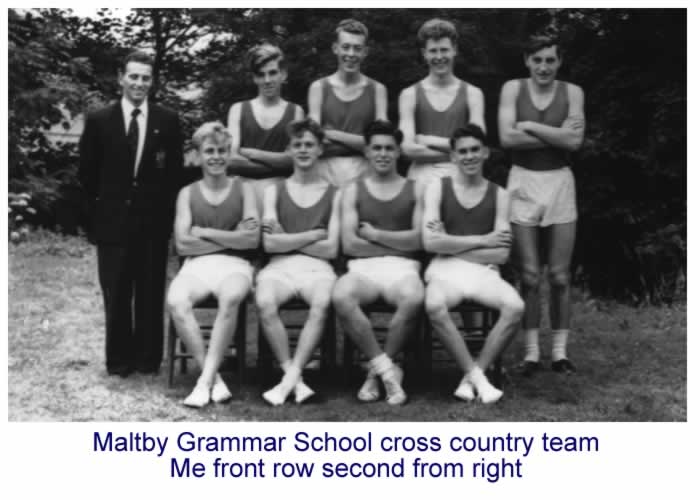 Born in 1938
in Dinnington, a coal mining village in South Yorkshire, I had a happy childhood
doing well at school and raising hopes in a proud mam and dad. I enjoyed my
sport as a youth playing soccer and cricket for the school and village teams.
The love for my boyhood hero teams of Sheffield Wednesday soccer and Yorkshire
cricket elevens has continued to this day, even if they have both seen better
days. Running then was with the Maltby Grammar School cross-country team, covering
what seemed amazing distances of two or three miles - wearing cheap canvas tennis
shoes.
Born in 1938
in Dinnington, a coal mining village in South Yorkshire, I had a happy childhood
doing well at school and raising hopes in a proud mam and dad. I enjoyed my
sport as a youth playing soccer and cricket for the school and village teams.
The love for my boyhood hero teams of Sheffield Wednesday soccer and Yorkshire
cricket elevens has continued to this day, even if they have both seen better
days. Running then was with the Maltby Grammar School cross-country team, covering
what seemed amazing distances of two or three miles - wearing cheap canvas tennis
shoes.
I was a healthy young man, apart from epilepsy which started at adolescence.
It was brought under control with drugs, leaving me able to live a normal life
from my mid twenties – but I have many bitter recollections of the unfair discrimination
which existed then. First exclusion by the school head from trips away, then
my first choice career in the RAF had to be discarded, followed by the second
one in teaching. I’m now glad that both those options were closed off for me,
but it opened my eyes to the unfairness which hits the disabled. Mam was a great
support through those troubles; her care and outlook on life would have been
a great influence in my leaning to help in charity work where I thought I could
make a difference.
After school, a few years as a junior scientist in the coal industry quickly showed me that there was no real future there and so I ventured to the big city of London to see if the pavements were lined with anything worth picking up. That was a culture shock to the young man who had hardly left Yorkshire before – little did I know how much of the world I was to see.
After false starts with a clothing firm and a chain store, at the age of 24
I managed to get entry to the Civil Service in the Department of the Postmaster
General – later to produce British Telecom as the telco portion split away and
was then floated on the stock market a few years later. This change to a company
which needed to make money and to compete in the fast changing communications
world, produced a need to cut staffing costs. At 51 years old, I was the right
age at the right time for the golden handshake – and I let my bosses know that
I would be only too happy to be the sacrificial lamb if the terms were right.
They were and I was off so fast you could not see the backside for dust.
During the 27 years covered by the last paragraph, I had managed to get married
twice and father Stephen and Andrew with my second wife Jackie. I recognize
now that I was perhaps too strict a dad, expecting too much from sons who wanted
to please me. My pressure on them probably had a negative effect, but when I
realized that, their school days were over and it was too late. The important
thing is though, they are both happy and well. The on-set of cancer brought
us much closer with them both coming out to South Africa and Australia to see
their old dad while he was still here. Jackie gets her part of the story later.
Back to sport – where else? The sporting life of this 20 year old young man
had been rudely interrupted by a motor cycle crash on the way to work whilst
still in South Yorkshire. A damaged knee prevented any further competitive soccer
– two attempted come-backs accompanied by screams, as the leg stuck out for
the ball could not take the twisting anymore, forced me to look at hockey as
the nearest I could get to soccer. It was a wonderful competitive game, but
it too produced problems, with the bending to one side whilst running. Back
problems, started, grew worse and after a six month spell off work cured only
by a spell in hospital and a laminectomy, that sport too had to go.
Running -The First Years
Boxing Day 1983 saw me walking off the Christmas
Day excess and walking past the Dartford Harriers athletics centre. I spotted
a man, who looked even older than my then 44 years of age, running around the
track. I reckoned I could do that – and that I probably needed to, just to ward
off the rolls and chubby bits which were starting to appear. So, the next Sunday,
I drove, (yes, drove and not walked), the mile to the park containing the athletics
centre and managed to run one lap around the park perimeter, which was also
about a mile. The following Sunday, I really went to town and did two laps but
did not feel shattered at the end as in the previous week’s inaugural run.
.
It went from there, gradually building up the frequency and length of the runs until I started looking for a first race. This was to be a half marathon, (13.1 miles), at Waltham Cross, (north of London), which took me 1hr 46 mins. How well I still remember that first race including the mixing and chatting with the other runners after the race – I was hooked. Next stop was down to the Dartford Harriers running club to see whether they would accept a slow old man, which was how I saw myself, as a member. I soon realized that there were many older than me, with over 60s being quite common and even the occasional over 70 being seen. The marathon boom had just started, meaning that my target soon became my first marathon, the London Marathon, (26.2miles), in 1984. That target was met in 3hr 42 min and I was now really enjoying my running and becoming fairly competitive, at least in my age group.
One day after a training spell, one of the club top runners asked me if I had
ever thought about the London to Brighton run, now that I had two or three marathons
under the belt and a best time down to 3hr 23 min. I thought this was a joke
and that no one would ever run that far; it was after all more than a double
marathon at 53 miles. How little I knew – and the running hook was about to
go in even further.
I found that one of the ‘older than me’ runners, dear old Peter Sargeant, was attempting his fourth London to Brighton and he really needed a back up runner to accompany him in the later stages, carrying drinks, sponges etc., so I agreed to help. I was bewitched with the race and the whole idea of being able to run that distance. Now having seen it first hand - it became my new target.
In those days the organizers the Road Running Club, (RRC),
were quite elitist only allowing entry to runners who could beat 3 hr 15 min
for the standard marathon, or complete another ultra-marathon in a time which
the RRC would accept as proof that the London Brighton
cut off time of 8hr 15 minutes could be met. Those old targets were discarded
long ago as the size of the field fell alarmingly, threatening the very existence
of the race. I could not get inside the 3hr 15 marathon target, although I would
later, so I decided to go for the ultra marathon entry route, selecting the
Grantham to Lincoln & return 100 km run in June 1986.
The race director there was the wonderful old eccentric Ron Hindley and his
lovely, but late, wife Ona. Ron, who I have always addressed as my mentor, gave
me so much sound advice about how to pace this first real ultra and seemed as
delighted as I was when I came home just inside the 12 hour cut-off. Not fast
enough for London – Brighton, but I didn’t care, I had my first ultra done and
was looking forward. Ron and that race were my introduction to the 100
km Association, which had been founded purely for that Lincoln race to
get round the running establishment’s rule that runners must be members of a
running club.
When Ron eventually decided to retire as Race Director, both the race and the
100 Km Association were in danger of folding, but
a few of the runners decided to keep the club going as a nationwide organization,
with me ending up as treasurer and Geoff Oliver, of whom more later, as chairman.
The Association was on its way to being easily the largest ultra running club
in the UK.
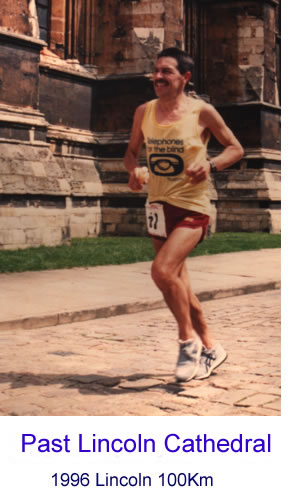 But, I have jumped
ahead of myself in the story. Charity fund raising, usually through running,
has played a major part in my later years – the 1987 Lincoln to Grantham 100
km was to be the first such race. I had earlier met John Richardson, Chairman
of the charity Telephones for the Blind, through my job as manager of British
Telecom’s billing system. The charity paid installation and 50% of rental costs
for people who were blind and lived alone – I could not think of a better charity
to run for and of course, my job in British Telecom Headquarters put me in a
ideal spot to raise funds. Part of Ron’s planning for his race included a charity
cup, awarded to the runner raising the most for charity. That was the part of
the race which I won!
But, I have jumped
ahead of myself in the story. Charity fund raising, usually through running,
has played a major part in my later years – the 1987 Lincoln to Grantham 100
km was to be the first such race. I had earlier met John Richardson, Chairman
of the charity Telephones for the Blind, through my job as manager of British
Telecom’s billing system. The charity paid installation and 50% of rental costs
for people who were blind and lived alone – I could not think of a better charity
to run for and of course, my job in British Telecom Headquarters put me in a
ideal spot to raise funds. Part of Ron’s planning for his race included a charity
cup, awarded to the runner raising the most for charity. That was the part of
the race which I won!
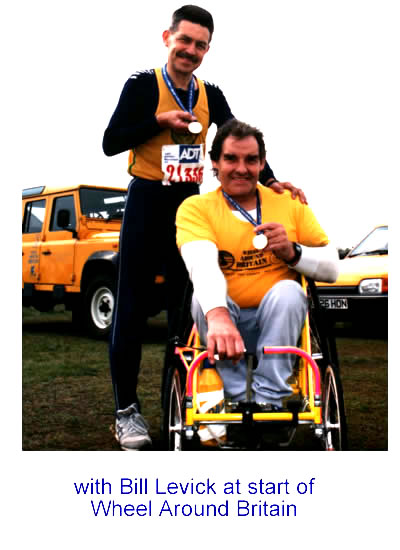
It was at the following year’s charity dinner, hosted by Lincoln
Cathedral, that I met Geoff Oliver and a fascinating wheelchair athlete Bill
Levick. I had actually met Bill earlier during the race as he sped past me going
downhill on his super lightweight racing chair, then I took him back again on
the ups. Chatting to him at the charity dinner, I learned that Bill had a vision
of wheeling around Britain to raise funds for disabled athletes. He had faced,
first-hand, the difficulty of unemployment which is far more common amongst
the disabled more than it is in the ranks of the able bodied. That lack of income
makes the purchase of sporting equipment, which often has to be tailor made
around the disability, even more of a problem. It certainly put my grumbles
about the cost of running shoes into perspective. At this stage, I knew there
was very good chance that I would be leaving British Telecom within a year or
so and would have time to spare. That charity dinner led to Bill & I planning
his route with me getting the support of British Telecom’s Community Welfare
group to equip Bill with a towing vehicle, a multi berth caravan and a second
support car. The new charity ‘Sports Foundation for the Disabled’ was duly registered
with the Charity Commission and with the help of other friends, we were off
around the UK, with a first leg in the 1990 London Marathon.
Bill’s journey took him 4 months and produced nearly £50,000 from company donations and generous public along the route. I am still on the board of trustees and act as treasurer even though not in the UK. Anno Domini has caught up with Bill too; his racing days are over but he still promotes disabled sport where he can.
I was to run the wonderful London to Brighton race five times in later years,
with my ultra running improving to where I was close, but not quite good enough,
to make the UK 24 hours team. But what a great time I had, touring all round
the UK & Europe in my camper van, usually with Jackie, to combine holidays
with races. Friends made and places visited, for which I have running to thank.
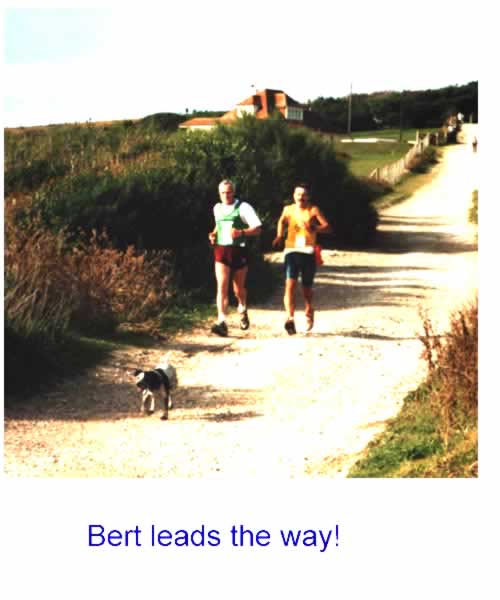 Jackie and I acquired
my great running friend, Bert, from Geoff Oliver, who had found himself saddled
with three dogs as his kids hit matrimonial problems. Bert was a young dog and
trained quickly. He could be seen most days accompanying me on training runs
around Dartford – then it came to trying him in some of the trail races and
did he have fun! Most of the UK trail runners knew and loved Bert - he must
have clocked up over 50 trail races at distances of up to 50 miles. He knew
what the running bag and campervan on Sunday morning meant – a trip to see running
pals again, out in the fields and on trails for hours with dips in the river
sometimes and a really good feed afterwards as the host club inevitably spoiled
him. It was amazing how he remembered the way on courses we had done before.
I was the one with the route description and still took the wrong turning many
times, having to apologise to a illiterate dog who had been right all along!
Jackie and I acquired
my great running friend, Bert, from Geoff Oliver, who had found himself saddled
with three dogs as his kids hit matrimonial problems. Bert was a young dog and
trained quickly. He could be seen most days accompanying me on training runs
around Dartford – then it came to trying him in some of the trail races and
did he have fun! Most of the UK trail runners knew and loved Bert - he must
have clocked up over 50 trail races at distances of up to 50 miles. He knew
what the running bag and campervan on Sunday morning meant – a trip to see running
pals again, out in the fields and on trails for hours with dips in the river
sometimes and a really good feed afterwards as the host club inevitably spoiled
him. It was amazing how he remembered the way on courses we had done before.
I was the one with the route description and still took the wrong turning many
times, having to apologise to a illiterate dog who had been right all along!
Bert is still as fit as a fiddle and shoots off after every runner he spots,
ready for another run. He is now 14 years old and he has now outrun me. On the
few occasions I got back to the UK, and whilst I was still fit, we would be
off again on the local trails and in the streams. He is a great friend still
for Jackie.
How I miss that dog!
Other than running
Just in case you are thinking it was running, running and more running, you
are nearly right - but not quite.
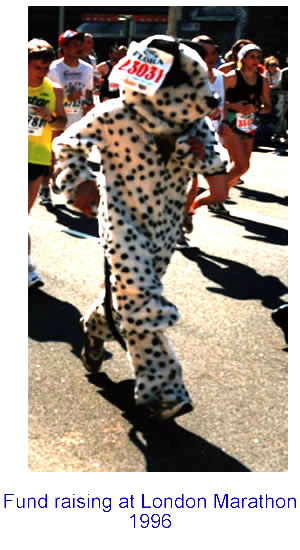 Telephones
for the Blind, the charity for which I raised my first sponsored run proceeds,
was struggling. Its income was falling fast and it was rapidly approaching the
stage where the help it could offer to blind people towards their phone costs
was meaningless. I became the charity’s first ‘paid’ employee, drawing a token
£5,000 per annum(p.a.), for what was usually 60 hours per week, but boosting
its income from around £40,000 p.a. to nearly £200,000 p.a. I was there for
about seven years, but there were too many sour voices on the charity board
who thought that raising funds was so simple and that they could do better,
or they could get someone else to do better, for zero cost. That ingratitude
infuriated me and I eventually departed, but I did leave a sound database of
donors and fund raising activities and recommendations of how to continue. I
understand that Telephones for the Blind is now back in the position it was
before I joined – income dangerously low and still falling!!
Telephones
for the Blind, the charity for which I raised my first sponsored run proceeds,
was struggling. Its income was falling fast and it was rapidly approaching the
stage where the help it could offer to blind people towards their phone costs
was meaningless. I became the charity’s first ‘paid’ employee, drawing a token
£5,000 per annum(p.a.), for what was usually 60 hours per week, but boosting
its income from around £40,000 p.a. to nearly £200,000 p.a. I was there for
about seven years, but there were too many sour voices on the charity board
who thought that raising funds was so simple and that they could do better,
or they could get someone else to do better, for zero cost. That ingratitude
infuriated me and I eventually departed, but I did leave a sound database of
donors and fund raising activities and recommendations of how to continue. I
understand that Telephones for the Blind is now back in the position it was
before I joined – income dangerously low and still falling!!
I also became a magistrate on the Dartford Bench. What a fascinating insight
into how the other half live, drugs, robbery, incest, violence, regular drunkards,
traffic offences to name just a few of the types of cases. Most came up with
a good excuse, even if they did have a record as long as your arm. Unfortunately
the general public do not understand that magistrates have strict limitations
on how they can treat offenders – depending on the offence. The idea that vengeance
equals justice is often in the public’s mind, understandably where victims and
their families are concerned. Pure vengeance is not the aim of the justice system,
for it solves nothing, rather it is concerned firstly, with punishment to ‘persuade’
the offender and others not to repeat the trick and secondly, with taking the
offender out of circulation if they are a danger to the public. The out of circulation
bit is the big problem though, whether in UK, Australia or almost anywhere else
in the world. Re-habilitation is secondary and a long way secondary at that,
to budgetary problems giving prisons overcrowding and staff shortages, with
the result that many come out worse than when they went in. The theory that
a longer sentence is a better sentence is not borne out in practice. It has
political appeal, but nothing else to commend it. If conviction and deprivation
of liberty, with enforced absence from family and friends, is not effective
after six months, it will never be effective.
the story continues
 An
autobiography of a well known British long distance runner Graham Ives, concentrating
on the last five to six years of his life. This period covers his falling
in love and then being hit by cancer. His four year cancer battle, raising
funds for cancer research where ever possible, has inspired many. Even though
the battle is now lost, he is still fund-raising via this book. The last four
years also covers his time in South Africa and a move to Australia.
An
autobiography of a well known British long distance runner Graham Ives, concentrating
on the last five to six years of his life. This period covers his falling
in love and then being hit by cancer. His four year cancer battle, raising
funds for cancer research where ever possible, has inspired many. Even though
the battle is now lost, he is still fund-raising via this book. The last four
years also covers his time in South Africa and a move to Australia. Born in 1938
in Dinnington, a coal mining village in South Yorkshire, I had a happy childhood
doing well at school and raising hopes in a proud mam and dad. I enjoyed my
sport as a youth playing soccer and cricket for the school and village teams.
The love for my boyhood hero teams of Sheffield Wednesday soccer and Yorkshire
cricket elevens has continued to this day, even if they have both seen better
days. Running then was with the Maltby Grammar School cross-country team, covering
what seemed amazing distances of two or three miles - wearing cheap canvas tennis
shoes.
Born in 1938
in Dinnington, a coal mining village in South Yorkshire, I had a happy childhood
doing well at school and raising hopes in a proud mam and dad. I enjoyed my
sport as a youth playing soccer and cricket for the school and village teams.
The love for my boyhood hero teams of Sheffield Wednesday soccer and Yorkshire
cricket elevens has continued to this day, even if they have both seen better
days. Running then was with the Maltby Grammar School cross-country team, covering
what seemed amazing distances of two or three miles - wearing cheap canvas tennis
shoes.  But, I have jumped
ahead of myself in the story. Charity fund raising, usually through running,
has played a major part in my later years – the 1987 Lincoln to Grantham 100
km was to be the first such race. I had earlier met John Richardson, Chairman
of the charity Telephones for the Blind, through my job as manager of British
Telecom’s billing system. The charity paid installation and 50% of rental costs
for people who were blind and lived alone – I could not think of a better charity
to run for and of course, my job in British Telecom Headquarters put me in a
ideal spot to raise funds. Part of Ron’s planning for his race included a charity
cup, awarded to the runner raising the most for charity. That was the part of
the race which I won!
But, I have jumped
ahead of myself in the story. Charity fund raising, usually through running,
has played a major part in my later years – the 1987 Lincoln to Grantham 100
km was to be the first such race. I had earlier met John Richardson, Chairman
of the charity Telephones for the Blind, through my job as manager of British
Telecom’s billing system. The charity paid installation and 50% of rental costs
for people who were blind and lived alone – I could not think of a better charity
to run for and of course, my job in British Telecom Headquarters put me in a
ideal spot to raise funds. Part of Ron’s planning for his race included a charity
cup, awarded to the runner raising the most for charity. That was the part of
the race which I won!
 Jackie and I acquired
my great running friend, Bert, from Geoff Oliver, who had found himself saddled
with three dogs as his kids hit matrimonial problems. Bert was a young dog and
trained quickly. He could be seen most days accompanying me on training runs
around Dartford – then it came to trying him in some of the trail races and
did he have fun! Most of the UK trail runners knew and loved Bert - he must
have clocked up over 50 trail races at distances of up to 50 miles. He knew
what the running bag and campervan on Sunday morning meant – a trip to see running
pals again, out in the fields and on trails for hours with dips in the river
sometimes and a really good feed afterwards as the host club inevitably spoiled
him. It was amazing how he remembered the way on courses we had done before.
I was the one with the route description and still took the wrong turning many
times, having to apologise to a illiterate dog who had been right all along!
Jackie and I acquired
my great running friend, Bert, from Geoff Oliver, who had found himself saddled
with three dogs as his kids hit matrimonial problems. Bert was a young dog and
trained quickly. He could be seen most days accompanying me on training runs
around Dartford – then it came to trying him in some of the trail races and
did he have fun! Most of the UK trail runners knew and loved Bert - he must
have clocked up over 50 trail races at distances of up to 50 miles. He knew
what the running bag and campervan on Sunday morning meant – a trip to see running
pals again, out in the fields and on trails for hours with dips in the river
sometimes and a really good feed afterwards as the host club inevitably spoiled
him. It was amazing how he remembered the way on courses we had done before.
I was the one with the route description and still took the wrong turning many
times, having to apologise to a illiterate dog who had been right all along! Telephones
for the Blind, the charity for which I raised my first sponsored run proceeds,
was struggling. Its income was falling fast and it was rapidly approaching the
stage where the help it could offer to blind people towards their phone costs
was meaningless. I became the charity’s first ‘paid’ employee, drawing a token
£5,000 per annum(p.a.), for what was usually 60 hours per week, but boosting
its income from around £40,000 p.a. to nearly £200,000 p.a. I was there for
about seven years, but there were too many sour voices on the charity board
who thought that raising funds was so simple and that they could do better,
or they could get someone else to do better, for zero cost. That ingratitude
infuriated me and I eventually departed, but I did leave a sound database of
donors and fund raising activities and recommendations of how to continue. I
understand that Telephones for the Blind is now back in the position it was
before I joined – income dangerously low and still falling!!
Telephones
for the Blind, the charity for which I raised my first sponsored run proceeds,
was struggling. Its income was falling fast and it was rapidly approaching the
stage where the help it could offer to blind people towards their phone costs
was meaningless. I became the charity’s first ‘paid’ employee, drawing a token
£5,000 per annum(p.a.), for what was usually 60 hours per week, but boosting
its income from around £40,000 p.a. to nearly £200,000 p.a. I was there for
about seven years, but there were too many sour voices on the charity board
who thought that raising funds was so simple and that they could do better,
or they could get someone else to do better, for zero cost. That ingratitude
infuriated me and I eventually departed, but I did leave a sound database of
donors and fund raising activities and recommendations of how to continue. I
understand that Telephones for the Blind is now back in the position it was
before I joined – income dangerously low and still falling!!